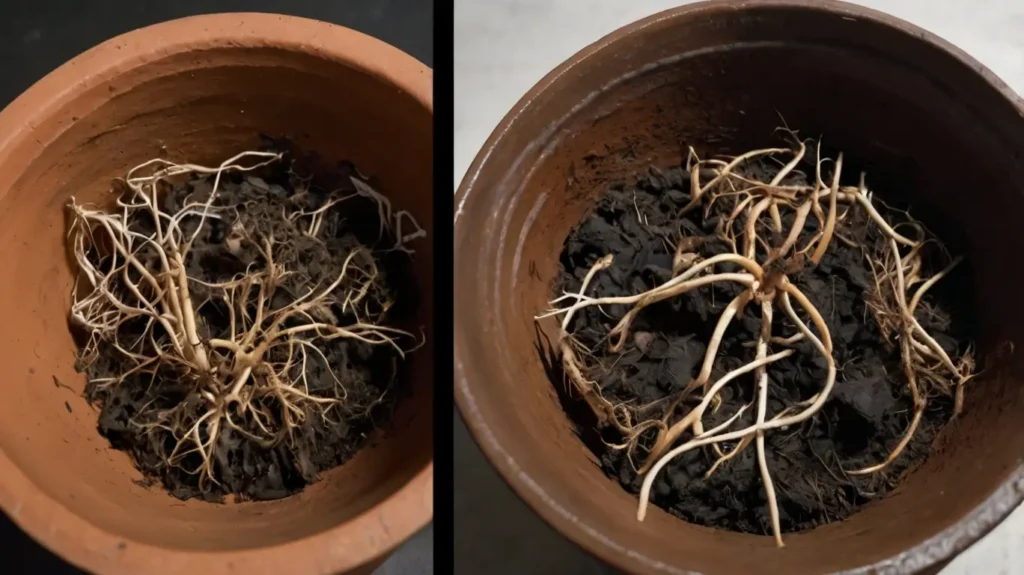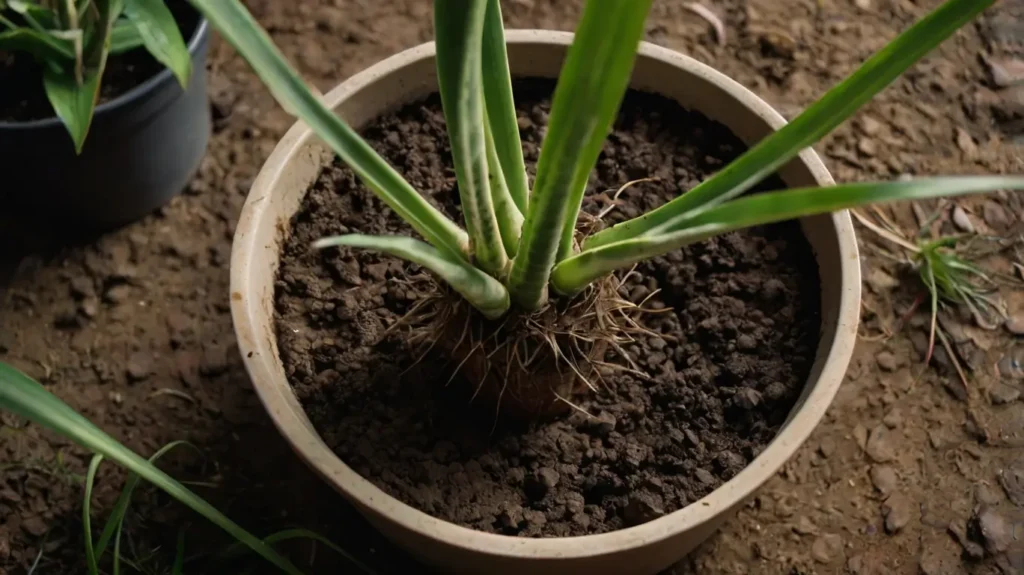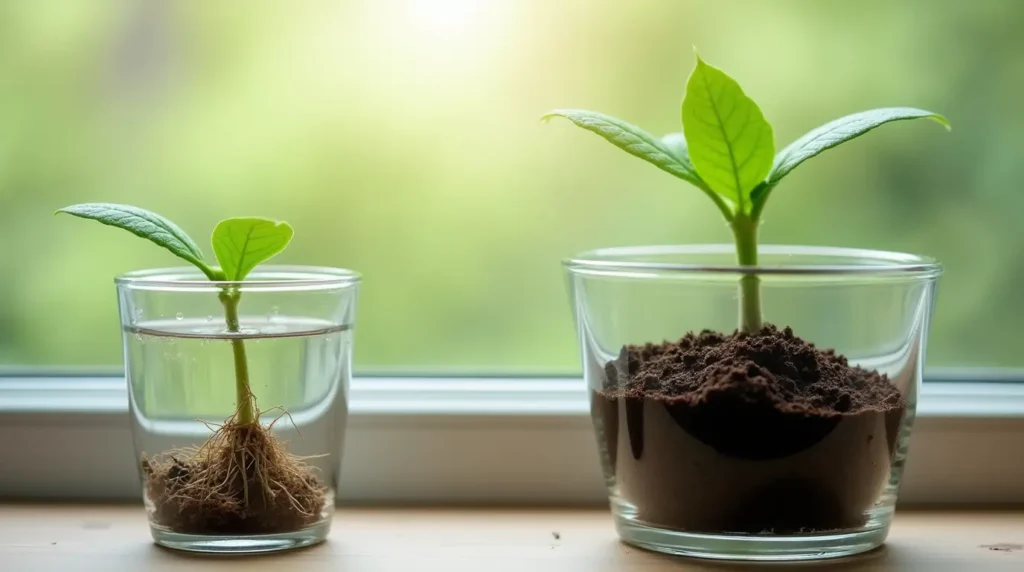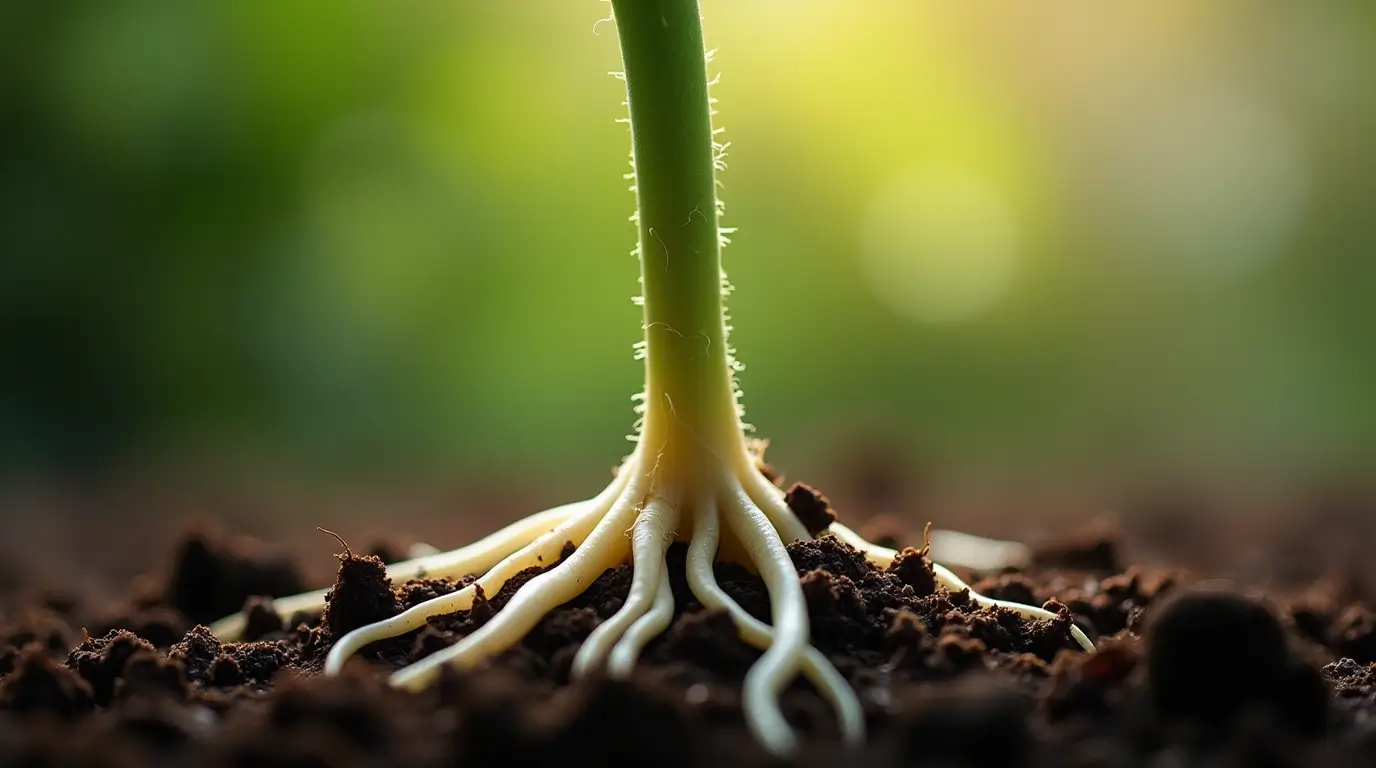Snake Plant Roots: The Ultimate Guide to Strong Roots.
Is your snake plant looking a little worse for wear? Before you blame the lighting or humidity, there’s a hidden factor you might be missing – what’s happening underground.
The truth is, snake plant roots tell the real story of your plant’s health.
Think of roots as the plant’s hidden support system. When they’re strong, your snake plant stands tall with those gorgeous sword-like leaves.
But when problems arise below the soil, the whole plant suffers. Maybe you’ve noticed yellowing leaves, a mushy base, or stunted growth – all classic signs that something’s wrong with the root system.
The good news? With the right knowledge, you can:
- Spot early warning signs of snake plant root rot
- Master perfect snake plant root care techniques
- Prevent common snake plant root problems before they start
Whether you’re a new plant parent or a seasoned green thumb, understanding roots is the key to keeping your snake plant thriving for years.
Let’s roll up our sleeves and get to the root of the matter (yes, another pun – we promise they’ll get better).
By the end of this guide, you’ll be able to diagnose issues, implement solutions, and grow the healthiest snake plant roots you’ve ever seen. Ready to become a root expert? Let’s begin.
Understanding Snake Plant Roots
How Snake Plant Roots Function

Snake plants (Sansevieria) don’t grow roots like most houseplants—they develop rhizomatous roots, thick underground stems that spread horizontally. These specialized roots serve two key purposes:
- Water Storage – Rhizomes store moisture, allowing snake plants to survive drought-like conditions (perfect for forgetful waterers!).
- Natural Propagation – New shoots emerge from these rhizomes, creating those satisfying clusters of leaves over time.
Here’s what makes them unique:
✔ Drought-tolerant – They thrive on neglect, needing water far less often than tropical plants.
✔ Overwatering risks – Their water-storing roots rot easily if left in soggy soil.
✔ Root-bound preference – Unlike fussy plants, snake plants actually grow better when slightly cramped in their pots.
Signs of Healthy vs. Unhealthy Roots
Spotting root trouble early saves your plant’s life. Here’s what to look for during repotting or if your snake plant shows distress:
| Healthy Roots | Unhealthy Roots |
|---|---|
| Firm, white or pale yellow | Mushy, dark brown or black |
| Earthy, fresh soil smell | Sour, rotten odor |
| Evenly distributed in soil | Clumped or slimy |
| Visible new growth (pale tips) | Brittle or disintegrating |
Pro Tip: Gently wiggle the base of your snake plant occasionally. If it feels loose or wobbly, root rot may be lurking below the soil line.
Want to test your plant’s root health? Wait until the soil is dry, then carefully lift the plant from its pot for a quick inspection. Healthy snake plant roots should feel sturdy—like crisp carrots—not soft like overcooked noodles.
Common Snake Plant Root Problems & Solutions
Snake Plant Root Rot (The Silent Killer)
Root rot is the #1 assassin of snake plants, often going unnoticed until it’s almost too late. Here’s how to spot and stop it:
What Causes It?
- Overwatering (the most common mistake)
- Poor drainage (no holes in the pot = trouble)
- Heavy, compact soil (roots can’t breathe)
Warning Signs
✔ Yellowing, mushy leaves (starting at the base)
✔ Soft, darkened stem near the soil
✔ A swampy or rotten smell from the pot
✔ Soil that stays wet for 10+ days
Emergency Rescue Plan
- Unpot Immediately – Gently remove the plant and shake off old soil.
- Surgery Time – With clean scissors, cut away all dark/mushy roots (healthy ones are firm and white).
- Repot Smart – Use fresh, fast-draining mix (try 2 parts cactus soil + 1 part perlite).
- Water Diet – Wait 7-10 days before watering, then only when top 2″ of soil are bone dry.
Pro Tip: If rot has spread to the leaves, propagate healthy top sections as backups!
Root Bound Snake Plant – Good or Bad?

Snake plants send mixed signals about tight spaces. Here’s the real deal:
The Upside of Being Root Bound
✓ Encourages flowering in mature plants (rare indoors!)
✓ Prevents overwatering (less soil = faster drying)
✓ Creates a fuller look as pups emerge
When It Goes Too Far
✗ Roots coil tightly in circles, strangling themselves
✗ Soil dries out impossibly fast (daily watering needed)
✗ Plant stops growing or cracks its pot
Time to Repot? Do This:
- Check Underneath – Roots sneaking out drainage holes? It’s time.
- Go Slightly Bigger – Only 1-2″ wider than the current pot.
- Loosen Gently – Untangle outer roots to encourage new growth.
Fun Fact: A slightly root-bound snake plant often grows faster than one in a huge pot!
Best Practices for Snake Plant Root Care
Choosing the Right Soil
Snake plants demand “tough love” soil—the kind that says “I care, but I won’t smother you.” The perfect mix:
- 50% succulent/cactus soil (the nutrient base)
- 30% perlite or pumice (for oxygen flow)
- 20% coarse sand or orchid bark (drainage boost)
Why this works:
- Mimics their native arid habitats
- Prevents water from pooling around roots
- Allows roots to breathe and expand
Avoid at all costs:
✗ Regular potting soil (too moisture-retentive)
✗ Pure peat moss (compacts over time)
✗ Decorative rocks at the bottom (creates a “bathtub effect”)
Watering Do’s and Don’ts
✅ Do:
- Water like a desert rainstorm – Soak thoroughly until water runs out the drainage holes, then wait weeks before repeating.
- Use the “finger test” – Only water when the top 2 inches of soil are completely dry (about every 3-4 weeks in average homes).
- Choose terracotta pots – Their porous walls help soil dry faster.
❌ Don’t:
- Use ice cubes (tropical plants ≠ snow cones)
- Water on a schedule – Your plant doesn’t care what day it is.
- Let it sit in a saucer of water – Empty excess within 30 minutes.
Pro Tip: In winter, water half as often. Dormant roots drink like retirees in Vegas—slow and steady.
Repotting for Stronger Roots
When to Repot:
- Every 2-3 years – Or when roots form a tight web visible at the soil surface.
- Spring/early summer – Active growth season = faster recovery.
Step-by-Step:
- Prep new pot – Just 1-2 inches wider than the root ball.
- Gently coax the plant out – Tip sideways and tap the pot’s edges.
- Root TLC –
- Untangle circling roots with your fingers
- Snip only clearly dead/dry roots (no “just in case” cuts)
- Fresh start – Plant at the same depth as before in your premium soil mix.
Aftercare:
- Wait 5-7 days before first watering to let roots heal.
- Skip fertilizer for 2 months to avoid burn.
Did You Know? A slightly stressed snake plant (from being root-bound) often produces more offsets (baby plants) than a comfy one. Tough love pays off!
Propagating Snake Plants Through Roots

Division Method (Best for Beginners)
Want to turn one snake plant into many? Division is your fastest ticket to new plants—and the best part? You’ll see growth weeks faster than other methods. Here’s how to do it right:
Step 1: The Extraction
- Water your plant 2 days before dividing (hydrated roots separate more cleanly).
- Turn the pot sideways and gently squeeze to loosen the root ball.
Step 2: Find the Rhizomes
Look for:
✔ Thick, pale horizontal stems (these are rhizomes)
✔ Clusters of leaves growing together
✔ Visible root strands
Pro Tip: If roots are tangled, soak them in lukewarm water for 10 minutes to soften.
Step 3: Make the Cut
- Use a sterile knife to slice through rhizomes—each section should have:
- At least 3 leaves
- Its own root strands
- Dust cuts with cinnamon (natural antifungal)
Step 4: Potting Up
- Plant divisions in small pots (4-5” diameter max)
- Use the same gritty soil mix as adult plants
- Water once, then wait 2 weeks before watering again
Expected Timeline:
- Week 1-2: Mild drooping (normal shock)
- Week 3-4: New growth emerges
- Month 3: Fully established plant
Leaf Cuttings (Slower but Effective)
No rhizomes? No problem. Even a single leaf can spawn new plants—though you’ll need patience (we’re talking 2-6 months).
The Right Way to Cut:
- Choose a healthy outer leaf
- Make clean 3-4” sections
- Critical: Note which end was closest to the roots!
- Let pieces dry 48 hours until calloused
Two Planting Options:
Option 1: Soil Propagation
- Stick cuttings 1” deep in dry succulent mix
- Wait 3 weeks before first watering
- Roots form in 4-8 weeks
Option 2: Water Propagation
- Place cuttings in water (only bottom 1/2” submerged)
- Change water weekly
- Transfer to soil when roots hit 2” long
Why This Takes Forever:
Snake plants prioritize root growth over leaves. That tiny cutting is building an entire root system from scratch!
Pro Tip: Variegated varieties (like ‘Laurentii’) often revert to plain green when propagated from leaf cuttings. Division preserves patterns.
Troubleshooting Propagation:
| Problem | Solution |
|---|---|
| Cuttings turn mushy | Too much water—let soil dry completely |
| No roots after 2 months | Dip in rooting hormone next time |
| New growth is pure green | Expected with leaf cuttings |
Frequently Asked Questions (FAQ)
How often should I water my snake plant?
Snake plants thrive on neglect. Water only when the soil is completely dry, typically every 2-4 weeks depending on:
✔ Season (every 4+ weeks in winter, 2-3 weeks in summer)
✔ Pot material (terracotta dries faster than plastic)
✔ Light exposure (brighter spots need water sooner)
Pro Tip: Stick a wooden skewer into the soil—if it comes out clean, it’s time to water.
Can snake plants recover from root rot?
Yes—if you act fast! Follow these steps:
- Unpot & inspect – Remove all soil and check roots.
- Trim the damage – Cut off mushy, blackened roots with sterile scissors.
- Repot in dry soil – Use a fresh, well-draining mix (cactus soil + perlite).
- Hold off watering – Wait at least 7 days before the first drink.
Survival rate:
- Mild rot (50%+ healthy roots left): 90% recovery chance
- Severe rot (only a few good roots): Propagate healthy leaves as backup
Do snake plants like deep pots?
No—they’re shallow-rooted. Ideal pots:
✔ Wider than deeper (roots spread horizontally)
✔ Only 1-2” larger than the root ball
✔ Drainage holes mandatory
Why shallow pots win:
- Prevents waterlogged soil at the bottom
- Encourages tighter root growth = happier plant
- Reduces risk of overwatering
Exception: Extremely tall varieties (like ‘Fernwood’) may need slightly deeper pots for stability.
Bonus Q: Why hasn’t my snake plant grown in a year?
Likely culprits:
- Too big of a pot (focusing on roots, not leaves)
- Low light (they survive in shade but won’t grow much)
- No fertilizer (try a diluted succulent feed 1-2x/year)
Fix: Move to brighter indirect light and check if roots are cramped. If pot-bound, repot to stimulate growth.
Final Tip:
Snake plants communicate through their leaves, but the real story is underground. Healthy roots = a plant that outlives your houseplants.
Final Thoughts: The Root of the Matter
Your snake plant’s roots are its lifeline—neglect them, and the whole plant suffers. But treat them right, and you’ll have a nearly indestructible houseplant that thrives for decades.
Key Takeaways:
✔ Healthy roots = firm, white, and earthy-smelling—mushy or foul odors mean trouble.
✔ Overwatering is the #1 killer—when in doubt, wait another week before watering.
✔ Repot every 2-3 years—but keep pots snug to encourage growth.
✔ Propagate wisely—division is fastest, while leaf cuttings test your patience.
Your Next Steps:
- Check your plant’s roots—if you’ve never looked, now’s the time.
- Adjust your watering habits—your snake plant will thank you.
- Share your experience—have you rescued a rotten snake plant? Grown one for 20+ years? We’d love to hear your story in the comments!
Remember: The best snake plant isn’t the one with the tallest leaves—it’s the one with the strongest roots. Now go give yours the care it deserves.
Happy growing! 🌿
P.S. Want to dive deeper? Explore our guide on [ snake plant benefits]
Want More Plant Tips? Follow Us!
🌿 YouTube: Watch detailed plant care tutorials.
📌 Pinterest: Discover stunning plant decor ideas.
🎥 TikTok: Get quick and fun plant hacks.
Join our plant-loving community today!”

